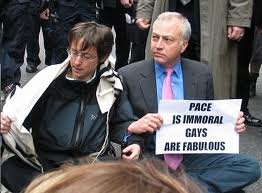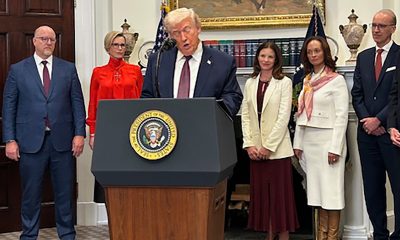Living
New York rabbi celebrates 20 years at LGBT synagogue
Rabbi Sharon Kleinbaum worked at Religious Action Center in D.C. before arriving at Congregation Beit Simchat Torah in 1992


Rabbi Sharon Kleinbaum and then-National Gay and Lesbian Task Force executive director Matt Foreman protest “Don’t Ask, Don’t Tell” in Times Square in 2007 (Photo courtesy of Congregation Beit Simchat Torah)
NEW YORK – Rabbi Sharon Kleinbaum of New York City’s Congregation Beit Simchat Torah had been in rabbinical school for less than a year when she attended a secret conference of gay and lesbian rabbinical and cantorial students and rabbis in Los Angeles in 1986 where attendees had to call a phone number once they landed to find out where the gathering was taking place. The Reconstructionist Jewish movement adopted a non-discrimination policy two years earlier, but the Reform and Conservative traditions still prohibited gay rabbinical students.
They faced potential expulsion over their sexual orientation.
“I was in the first class that was admitted under that [1984] policy,” Kleinbaum told the Washington Blade in a recent interview, noting her own tradition remained hostile to openly LGBT rabbinical students and gay issues in general. “It was all pretty cutting edge. We were all testing the waters. It was a very different time, so we were all figuring out how to both transform the Jewish community internally and the liberal Jewish community was no different.”
Kleinbaum spoke to the Blade shortly after she celebrated her 20th anniversary at Congregation Beit Simchat Torah, the country’s largest LGBT synagogue with 1,100 members that first held services at the Church of the Holy Apostles in Manhattan’s Chelsea neighborhood in 1973. The congregation has since returned to the same Episcopal parish to conduct their Friday night services because it has outgrown its previous location in the West Village.
AIDS was ravaging Congregation Beit Simchat Torah when she became its first full-time senior rabbi in Aug. 1992.
“We just had funerals constantly,” said Kleinbaum, who was director of congregational relations at the Religious Action Center in D.C. from 1990 until she arrived at Congregation Beit Simchat Torah. “I came to CBST and it was in the midst of an epidemic that was being largely ignored by the religious community and certainly by the government. So we were really under siege in those days.”
Roughly one third of Congregation Beit Simchat Torah’s members lost their battle with AIDS, while Kleinbaum said up to 75 percent of her male congregants were living with HIV. She also buried the synagogue’s president who had supported the hiring of a full-time rabbi a month after she arrived at Congregation Beit Simchat Torah.
“The primary motivation for having a rabbi come into the congregation was to respond to this crisis of AIDS. And it was a spiritual crisis that the synagogue was really reeling from the death and the illness and there was no end in sight of course at that time,” said Kleinbaum, who further noted that anti-AIDS stigma at the time only exacerbated the plight of those in the congregation living with the virus. “Religion was used constantly as ammunition, as a weapon against us and against people who were HIV-positive or had AIDS. So my presence to try and project a different image of God and of religion was very important both pastorally and politically.”
Activism extends beyond HIV, LGBT rights
In addition to her HIV/AIDS advocacy, Kleinbaum has publicly backed marriage rights for same-sex couples and other LGBT-specific issues. New York police arrested her and then-National Gay and Lesbian Task Force executive director Matt Foreman during a 2007 protest against “Don’t Ask, Don’t Tell” when they obstructed traffic in Times Square.
Kleinbaum was among the New York Board of Rabbi members taken into custody for civil disobedience during a protest against the 1999 police shooting of unarmed West African immigrant Amadou Diallo in the Bronx. More recently, she has spoken out against the New York Police Department’s controversial stop and frisk policy that critics maintain unfairly targets black and Latinos and other underrepresented groups.
“If we want a country to change and a world to change we have to be deeply in partnership and see our fight and struggle for human rights — it’s not just about who I am as a person literally. This I take from my Jewish tradition,” said Kleinbaum. “We are told over and over and over and over again, remember that you were slaves once in Egypt, therefore make sure you do everything you can to prevent the oppression of anyone else. No one else should be a slave.”
Kleinbaum remained humble when the Blade asked her about those who have identified her as among New York’s most influential Jewish leaders and one of the country’s most important rabbis.
“It’s wonderful to be recognized in that way if it helps also continuing our effort to transform the world,” she said. “I have one agenda; and that’s to transform the world. And I feel that only happens when people are really working hard together.”
Over the last two decades, the congregation’s High Holiday services at the Jacob K. Javits Convention Center have grown to include more than 4,000 people each year. Congregation Beit Simchat Torah also hopes to move into a new building on West 30th Street in Manhattan in 2014.
Judaism itself has changed since Kleinbaum attended rabbinical school in the mid-1980s.
The Reform, Conservative and Reconstructionist movements all admit openly gay rabbinical students and place them in synagogues and other congregational positions. These traditions also recognize same-sex weddings.
“These years since I started rabbinical school have been totally transformative and so it’s been very moving to be part of that,” said Kleinbaum.
As for Congregation Beit Simchat Torah, Kleinbaum said she hopes to further develop its social justice work over the next decade. She would also like to create what she described as an institute that examines the intersection of sexuality and religion.
“The intersection of sexuality and religion is a source of tremendous oppression in the world,” said Kleinbaum. “I’d like to create an institute which focuses on ways that religion can be a voice of liberation in areas of sexuality and religion.”

Electric-vehicle tax credits may have faded earlier this year, but EVs themselves are far from losing their spark. There are more charging stations than ever, battery ranges are longer and more realistic, and automakers have finally figured out that EVs don’t all need to look like geeky science projects or feel like failed beta tests.
Just look at these two compact electrics, which are futuristic, fun and flexible enough for work or play.
HYUNDAI IONIQ 5
$37,000 to $48,000
Range: 245 to 318 miles
0 to 60 mph: 4.5 to 7.4 seconds
Cargo space: 26.3 cu. ft.
PROS: Fast charging. Roomy cabin. Silky-smooth suspension.
CONS: Wide turning radius. Rear wiper not on all trims. Price creep.
After being introduced three years ago, what’s new for the latest Hyundai Ioniq 5? Mostly refinement. Charging is quicker, software is smarter and Hyundai continues to quietly listen to feedback, tweaking ride comfort and usability. Think of it as switching from messy eyeliner to a perfectly sharp wing.
Exterior styling remains one of this EV’s biggest conversation starters. Those pixel-inspired lights, crisp lines and slick hatchback-meets-crossover proportions exude refreshing confidence. There’s no trying to blend in, and that’s the point. Park this Hyundai anywhere and heads will turn.
On the road, the Ioniq 5 prioritizes calm over chaos. Steering is light, the suspension smooths out rough pavement and acceleration feels brisk without being aggressive. Safety tech is plentiful and well-calibrated—adaptive cruise control, lane-centering, blind-spot monitoring—all working together without seeming like a nervous backseat driver. IOW, this ride is supportive, not clingy.
Inside, the user-friendly cabin shines. The flat floor and long wheelbase create a lounge-like atmosphere, with excellent legroom and airy visibility. Seats are well-bolstered and available with eco-friendly materials, and the sliding center console adds flexibility. Cargo space is generous, and the wide windshield makes city driving stress-free. Alas, the rear wiper is only available on select models. Overall, though, I appreciated how everything looks modern without feeling cold.
What makes this Hyundai special is its vibe. An EV that embraces individuality without shouting about it.
Fun fact: The Ioniq’s ultra-fast charging can add hundreds of miles in under 20 minutes—perfect for those who hate waiting almost as much as they hate small talk on awkward first dates.
VOLKSWAGEN ID.4
$46,000 to $59,130
Range: 206 to 291 miles
0 to 60 mph: 4.4 to 7.7 seconds
Cargo space: 30.3 cu. ft.
PROS: Sure handling. Decent range. Good storage.
CONS: Body roll in curves. Fussy infotainment. No frunk.
The latest VW ID.4 focuses on polish. Software updates have fixed earlier frustrations, and overall drivability feels more cohesive. Less “learning curve” and more “hop in and go,” like a dependable bestie who doesn’t overthink things.
Styling-wise, this EV is intentionally inoffensive. Soft curves, friendly lighting and a familiar crossover shape make it approachable. While the ID.4 won’t turn heads like the Ioniq 5, that’s OK. It’s more akin to a classic outfit that always works—timeless, not trendy.
Driving the ID.4 is relaxed and predictable. This SUV prioritizes comfort over thrills, with a suspension tuned for daily commuting and long highway drives. Safety features are comprehensive and reassuring, including excellent lane assistance and collision-prevention systems. It’s the kind of car that quietly has your back, no drama required.
Inside, the ID.4 offers a calm, uncluttered cabin with good space for passengers and cargo alike. Rear-seat legroom is especially strong, making it a solid road-trip companion. The seats are plush, visibility is good and while the infotainment system isn’t the most intuitive, it’s improved enough to be more than tolerable.
The ID.4’s special sauce is balance. It doesn’t try to reinvent the wheel—it just electrifies it.
Fun fact: This is one of the most globally popular EVs, proving that sometimes being universally liked is a strength, not a personality flaw. Think, gold star gay who still surprises you.

Real Estate
Child- and pet-proofing your home for the holidays
It isn’t about being perfect but about being prepared

The holidays are meant to be joyful, cozy, and full of laughter — but if you have young children or pets, they can also feel a little chaotic. Twinkling lights, shiny decorations, guests coming and going, and tables full of tempting food can turn your home into a wonderland of curiosity and mischief. The good news? With a little thoughtful planning, you can keep the holiday magic alive while making your home safer for everyone who lives there.
There’s something oddly comforting about movies where animals go to war with holiday decorations, turning carefully strung lights and perfectly placed ornaments into chaos. Whether it’s a mischievous dog tangled in tinsel or a curious cat launching a full-scale assault on a Christmas tree, these scenes tap into a universal experience for pet owners.
The humor comes from the contrast: the human characters are trying to create warmth, tradition, and picture-perfect cheer, while the animals see the decorations as toys, obstacles, or personal enemies. The resulting destruction — trees tipping over, ornaments shattering, lights blinking out—feels exaggerated but relatable, especially during the already hectic holiday season.
Let’s start with decorations because they tend to be the biggest attraction. Ornaments sparkle, garlands dangle, and everything seems designed to be touched, pulled, or tasted. If you have little ones or pets, consider placing your most fragile ornaments higher on the tree and using shatterproof options on the lower branches. Tinsel and ribbon may look festive, but they can be dangerous if swallowed, so skipping them or keeping them well out of reach is a simple way to reduce risk without sacrificing style.
Holiday lights are another favorite fascination. Before hanging them, take a few minutes to inspect each strand for frayed wires or broken bulbs. Secure cords along walls or behind furniture so they’re harder to grab or chew and unplug them when you leave the house or head to bed. Not only does this help prevent accidents, but it also gives you one less thing to worry about during a busy season.
The Christmas tree itself can become a focal point for exploration. Make sure it’s sturdy and well-anchored so it doesn’t tip if a toddler tugs on a branch or a pet decides to investigate. If you use a real tree, cover the water base since tree water can contain additives that aren’t safe if consumed. For artificial trees, keep an eye out for loose pieces or needles that could become choking hazards.
Food is a big part of holiday celebrations, and it’s also one of the most common sources of trouble. Many traditional treats—like chocolate, grapes, raisins, alcohol, and foods containing xylitol—are dangerous for pets. Keep plates and serving dishes up high, secure the trash can, and gently remind guests not to slip pets or kids “just a little bite” without checking first. For children, be mindful of hard candies, nuts, and small treats that could pose choking risks.
Candles and fireplaces add warmth and charm, but they deserve extra caution. Flameless candles are a wonderful alternative if you want ambiance without worry. If you do use real candles, place them well out of reach and never leave them unattended. Fireplaces should always have a sturdy screen or gate, especially with crawling babies or curious pets nearby.
Holiday gatherings bring wonderful energy into your home, but they can also create new challenges. Doors opening frequently make it easier for pets to slip outside, so consider setting up a quiet, comfortable space where they can relax during busy get-togethers. This can help reduce stress for them and give you peace of mind. For children, stair gates, locked cabinets, and clear boundaries can help prevent accidents when there’s extra excitement in the air.
New toys and gifts are another thing to watch closely. Packaging, twist ties, plastic wrap, and especially button batteries should be cleaned up promptly. These items are easy to overlook in the excitement of gift-opening but can be dangerous if swallowed. Taking a few minutes to tidy up as you go can make a big difference.
Lastly, try to keep routines as steady as possible. The holidays naturally disrupt schedules, but familiar mealtimes, naps, walks, and bedtime rituals help children and pets feel secure. A calmer household often means fewer accidents and a happier experience for everyone.
At the end of the day, child- and pet-proofing your home for the holidays isn’t about being perfect but about being prepared. A few small adjustments can help you relax, enjoy your guests, and focus on what truly matters: creating warm, happy memories with the ones you love. When your home feels safe, the holidays feel even sweeter.
Valerie M. Blake is a licensed Associate Broker in D.C., Maryland, and Virginia with RLAH @properties. Call or text her at 202-246-8602, email her at [email protected] or follow her on Facebook at TheRealst8ofAffairs.
Real Estate
In real estate, trust the process
With rates coming down, we could see spring surge in buyers

The average 30-year mortgage rate is falling, little by slowly. With predictions that the rate will continue to adjust downward in the next year or two, there may be a busier spring market than we have seen in the last few year, especially for the DMV market, which has been reeling from thousands of layoffs this past year. The frenzied activity resulting from interest rates close to 3% for some borrowers will probably not occur; however, this spring could add up to be a few notches busier than the last.
What does this mean for buyers and sellers? Lender Tina Del Casale with Waterstone Mortgage says she has seen “low to mid 6’s as the average for conventional loans.” If rates continue downward into the 5% range, there may be more activity than we saw in the last year or two. This could release a little bit of pent up demand.
Many buyers will have found that for whatever reason, their current home is not meeting their needs. Sellers may want to finally take the plunge and put a for sale sign in the yard and online, now that they might find a more reasonable rate on their next home. This winter can be an opportunity to assess financial situations, home conditions, and optimize one’s chances to have a sale with more agreeable terms, or put one’s best foot forward in an offer. In addition to checking with a lender or favorite handy person, let’s review what sellers and buyers typically spend their energy negotiating while enjoying the lovely process called “going under contract”:
- Timelines – Sellers might want to have their house solidly under contract (papers signed, thumbs up from the lenders, all inspection items decided upon and settled) so that they can put an offer down on a new home, and then negotiate that timeline with the other sellers. Remember, making a move is not only about the buyer taking possession of a new home, but also about the sellers figuring out their situation as well.
- Sale Price – unfortunately for buyers, in the eyes of most sellers, “money talks.” So, in a non-competitive situation, a seller might be happy to just get one offer at a price that was within the desired range. As soon as another interested buyer enters the equation, it can become a little bit like RuPaul’s Drag Race, and one will have to lip sync for one’s life, honey! And only one buyer will get to hear the words, “condragulations!”
- Tone/Vibes/Energy in the Room – Remember: Human beings are emotional creatures. All of us have feelings. And all of us want to put energy into situations where we feel appreciated, where a level of self-awareness exists, and a sense that each side is trying one’s hardest to act in good faith. The best transactions I saw were where a little grace was the “grease on the wheels” of the transaction. Occasionally, a buyer had cold feet and wanted to see the unit a few more times before the settlement date, or a seller forgot to scrub the bathroom with a little extra elbow grease before the settlement date. Life happens; misunderstandings can occur. A wise therapist once said: “You don’t have to like it, but can you allow it?” The tone of one or both parties in the transaction can be what seals the deal, or results in one party exiting the contract. (In the case of the dirty bathroom, the seller left a check with the title company for the buyer to pay a housekeeper to come clean what they couldn’t.)
Joseph Hudson is a referral agent with Metro Referrals. He can be reached at 703-587-0597 or [email protected].


















